Yellow fruit with a large flat stone. A complete list of delicious exotic fruits and berries with a description. And Thai bananas are different!
Like any tropical country, Thailand is famous for its exotic fruits. Due to the high seasonality of harvesting, you can try any of the Thai fruits almost throughout the year.
Their prices are very low and affordable for everyone. But how to understand such an endless variety of exotic Thai fruits? Of course, you can try everything that pleases our eyes. But! Suddenly, the fruit turns out to be not at all as tasty as it seemed initially, or even turns out to be unsuitable for food.
The infinity of unique ingredients that we put into our cuisine in an irreplaceable place, without forgetting, of course, the contribution he has made to the world cuisine as dishes, some as exotic, as delicious and others as often as necessary, because in the most incredible products.
From Brazil and Mexico, where it grows spontaneously, pineapple has spread to many countries in the tropical zone: in Asia, Africa and America, where it is now grown. Scaled, oval fruits are topped with a crown of short, hard leaves. The fruit reaches maturity after 15-18 months of cultivation, then the flesh is golden yellow, with a pleasant smell, soft and melting. Pineapple is mostly consumed fresh, but it is also used for jam.
Let's try together to understand such a rich assortment of Thai berries and fruits. Let's talk about how to eat them correctly, what they taste and smell like, and whether they will harm our body. Below are photos with the names of fruits, their prices and season.
The most popular among tourists and locals are such fruits as: mango, mangosteen, durian, jackfruit, noina, dragon fruit, rambutan, papaya, passion fruit, herring, lychee, longan, longkong, carambola, guava, sapodila, tamarind, tangerine, pomelo and the more famous banana, melon, watermelon and coconut.
After fermentation, it can produce alcoholic beverages or vinegar. This fruit, also called the cinnamon apple, has over 450 different varieties. All of them are grown in the tropical regions of America, Asia and Africa. The skin of this oval fruit is made of grey-green scales and has a creamy pulp. white color, slightly yellowish and contains small black seeds with a sweet, aromatic and sweet taste. It is consumed raw, but it can also be used to juice succulents.
Each plant bears a diet of 60 to 200 fruits called "fingers". Their size varies by species and under their usually yellow skin, they contain fleshy and whitish flesh. The diets are harvested while still green and matured on specially designed cargo ships during their transport to the consumer countries. The sugar of this energy fruit is tolerated by diabetics. Banana is consumed fresh, dried or canned. It can also be processed into flour or used in some countries to produce alcoholic beverages.
Mango (English Mango, in Thai Ma-muang)
Price: from 35 to 100 baht per 1 kg. (1 baht is approximately 1.5 rubles). Depends on the season and the appetite of sellers.
Season: January to May
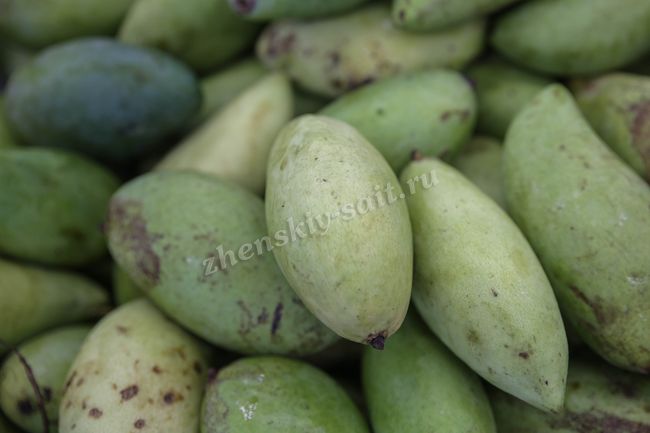

But it is also grown in many tropical countries in Asia and America. This yellow fruit can measure between 5cm and 12cm in length and once cut wide, its structure shows the shape of a five-pointed star, this very fragile fruit requires a lot of care when harvested. Three quarters of its maturity, carambola is stored in a warehouse under strict conditions of heat and hygrometry in order to be consumed in a timely manner. When ripe, carambola flesh presents a slight rhubarb flavor.
It is consumed in nature, in jam or in fruit salad. Lime is also known as lime or acid lime. It grows in South America, West Indies and Asia. This fruit is smaller than a regular lemon, and its soft, smooth rind remains green when ripe. Lime is mainly used for juice in cocktails and also in the kitchen for making raw macerated fish. There are many varieties of lime, such as soft lime and wild lime, or even makrut, which is a semi-wild lime that grows in Thailand.
One of the most popular fruits in Thailand and many other countries is the mango. But the fruits that are sold in our stores can never be compared with tender and juicy Thai ones. On top of the mango is a hard, inedible peel. Its color can vary from green to bright yellow or red, depending on the variety and its degree of maturity.
This fruit, the size of a large olive yellow-brown color, is grouped along long woody stems. Thus, each tree can provide up to 50 kg of fruit at maturity. There are several varieties, classified by their consistency at harvest time. The most popular are Deget Nur and Mehul, half soft. This very energetic fruit is consumed. But also sweets or stuffed with almond paste with pistachios.
It ripens in September-October. Its yellow, orange, soft and sweet flesh is delicious. This fruit is eaten fresh, boiled, dried, in the form of marmalade or syrup. In Mexico, its distillation allows the production of tequila. There are about 500 species in the Passiflora family. They are called flowers or passion fruits because their floral organs are made up of elements resembling nails, a hammer, and the crown of thorns of the passion of Christ. These plants are grown in Africa, Oceania, Asia and the Caribbean. Its purple flesh contains many seeds.
The most delicious mango variety, as in the picture above: bright yellow, pot-bellied. And bright yellow elongated.
The peel must be carefully cut with a knife. After that, you should cut the mango in half and remove a large bone from the center of the fruit. Now you can enjoy its juicy, honey pulp with an amazing aroma.
Here it is eaten both in its pure form and added to salads and other dishes and drinks.
Grenadilla is fresh, and is also used to make aromatic juices, ice cream, sherbet. This fruit of American origin has more than a hundred species and is grown in Brazil. Guava is a round or oval shaped fruit covered with smooth skin that varies in color from green to yellow. Its very juicy and aromatic pulp can be yellow, pink or red depending on the varieties. It is most commonly eaten but can also accompany white meat or fish dishes.
Guava can also be used to make jam, jelly, fruit paste, ice cream, or sorbet. The pomegranate is grown in tropical and subtropical regions. The name of this fruit comes from the impressive number of seeds contained under the hard and orange skin of this bay, more or less spherical and large, like an orange. Cultivated by the Moors in Spain during the Middle Ages, it gave its name to the city of Granada. The interior of this fruit consists of several alveoli containing small red seeds with a sour taste, the reddish flesh is sweet tasting and rich in water and very refreshing. composition of grenadine syrup.
Mangosteen (English Mangosteen, in Thai Mnog-khut)
Price: from 20 to 50 baht/kg.
Season: May to September
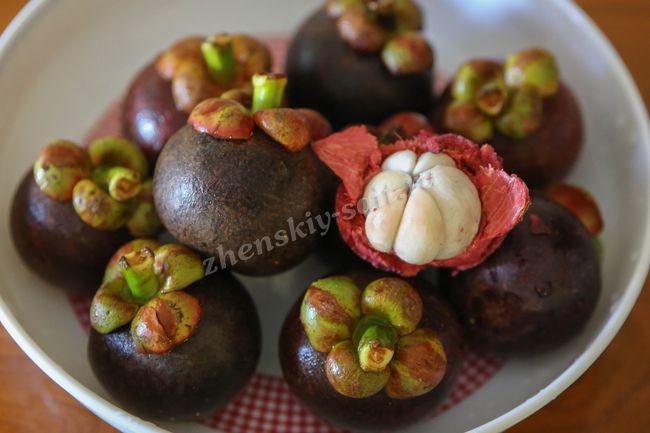
Be sure to try this real Thai fruit. It is covered with a dark purple rind that is not edible. Beneath it lies a juicy, slightly oily pulp that looks like garlic cloves. But in fact, it is sweet and pleasant to the taste. Sometimes small but hard bones can be caught in the pulp.
Yubu is widely known and appreciated in China and Syria. This fruit resembles an olive in size and shape, but its skin is smooth and tough red-brown. The white flesh of this fruit has a pleasant taste and is very nutritious food, easy to digest. The most common type of jujube in nature, but also in the form of dried fruits, candied fruits and dough. In its dry fruit form, jujube has been used for centuries in medicine.
Today, there are about 450 different species in the Mediterranean basin and in almost all tropical and subtropical regions where khakis resemble tomatoes, containing only 4-8 seeds. And the shiny ones can come in a variety of colors, ranging from yellow to red. Only mature that khaki can be consumed, but quickly because its preservation is difficult. Kaki consume nature, in jam or in marmalade and its taste is reminiscent of apricot.
The fruit itself is small, about the size of a tangerine. Thais advise eating it fresh, immediately after durian, as mangosteen cools the body and quenches thirst. Such a fruit is sold more often for 35 baht / kilogram. Peak harvest from April to September. Mangosteen contains a large amount of vitamins B and C, and is also a source of calcium and nicotinic acid.
This fruit originates from China and is now grown throughout the citrus production area. There are many varieties, and hybridization has created new fruits such as limequat. The kumquat is a small citrus fruit 2 to 4 cm long, yellow or orange in color, and its smooth, thin skin is perfectly edible with a sweeter flavor than its flesh. This allows for creasing and can serve as an accompaniment to some exotic dishes such as lacquered duck.
Lychee grows naturally in the low mountains of South China, from where it spread to different countries South-East Asia. It is also now grown in the West Indies, Florida and Africa. Its hard skin and covered with small red spines hides a white flesh, translucent and juicy, with a sweet taste. Lychees are consumed fresh, in fruit salad.
Durian (eng.Durian, Too-ree-an)
Price: from 20 to 100 baht
Season: May to August
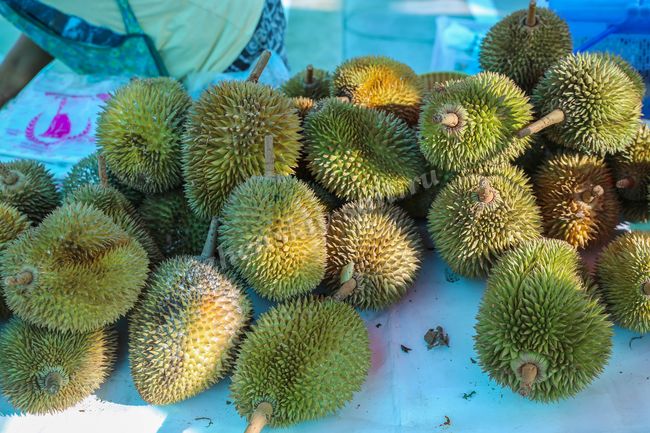

He was called the "King of Fruits" for a reason. Its large fruits can grow up to 8 kg in weight, and the hard, spiked fruit peel is very similar to a shell. The flesh of the durian itself is pale yellow in color and is divided into several parts. Thais consider durian an effective aphrozodiac. Everyone has heard of this fruit. He is famous for his specific, sharp and very bad smell. Many compare it to the smell of rotting meat or rotten eggs. It is about durian that they say "the taste of heaven, the smell of hell." But unlike just a disgusting smell, the fruit has a surprisingly pleasant and delicate taste, which is often compared with the taste of nuts and strawberries.
This fragile fruit is often preserved in syrup. The mangosteen is widely known in Malaysia and Indonesia, where it grows naturally, with almost 200 species, most of which are edible, and the mangosteen is a round bay with a diameter of 4 to 7 cm, covered with a thick and hard skin, purple in color. The flesh of the mangosteen, divided into several quarters containing oval seeds, is white or pink, very fragrant and tasty. Its delicate flavor makes for some of the most delicious exotic fruits ever.
This fruit is consumed fresh or in sorbet. This orange-yellow flesh can vary greatly in size and weight, ranging from 200 g to 1 kg. Its smooth, waxy skin ranges from green-orange to red, depending on variety and origin. Mango is rich in vitamins and minerals. It is consumed fresh, most often in fruit salad. It is also used in juices or nectar, or to make chutneys or jams.
When buying this fruit in Thailand, it is worth considering that with it you may not be allowed into the hotel precisely because of the smell, since it is very difficult to take it out of the room. Yes, and it is better to eat the pulp with gloves so that the smell of the fruit does not remain on your hands.
Durian is most often sold already completely ready to eat, that is, peeled and divided into separate pieces. When choosing such a fruit, be sure to ensure that the durian is butchered in front of you. And the bought fruit should be eaten as soon as possible. The longer the pieces of pulp interact with air, the more unpleasant the smell becomes. If you don’t want to eat durian right away, it’s better to buy it in a peel, and cut it yourself at home.
But he emigrated very early in Japan, and from there, throughout Asia, and also acclimatized in the Mediterranean basin. The fruit appears as a small yellow-orange oval apple. Its juicy flesh offers a sweet and sour or sweet taste. This fruit, rich in vitamin A 1, is also calcium.
Japanese loquat can be eaten as a jam or jelly. It is swimming to the son of the sea currents that the coconut tree has spread from Asia to all tropical regions and is protected by a smooth green shell that surrounds an extremely hard woody and fibrous layer, which is light brown in color and is a milky liquid that is very pleasant to drink. This coconut milk turns into a hard white pulp in the 9-12 months it takes for it to mature.
Because durian has warming properties, don't risk pairing it with alcohol. Because of the terrible smell, not everyone dares to taste this amazing fruit.
Jackfruit (English Jackfruit; Kha-nun)
Price: 30 to 60 per kilo.
Season: January to August
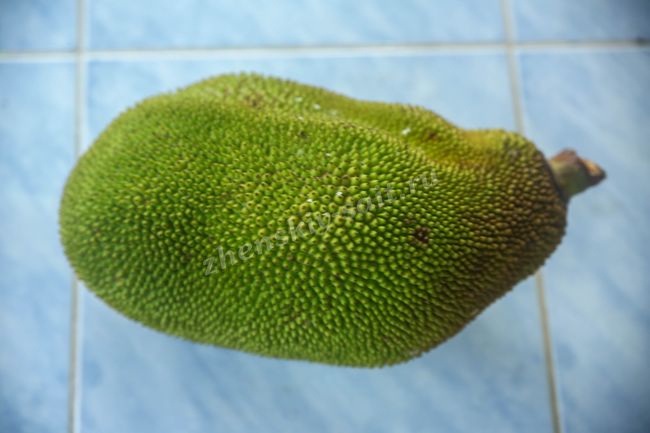
Cellulose consumed fresh, cut into pieces or ground, is used in many salty or sweet preparations. This tropical fruit from Mexico is grown in America, Asia and Africa. It is shaped like an ovoid bay of variable size and can weigh several kilograms, the papaya can resemble a melon or a large cucumber, and the orange-colored flesh is very firm and juicy. Papaya is eaten fresh, in a fruit salad or in jam, and it can also be prepared in a variety of ways, such as confiture or boiled like a vegetable.
Pepino is also called pear melon. Pepino is covered in yellow-orange skin covered with purple brown stripes. In the interior, the firm and compact orange flesh contains a few seeds, and the sweet and refreshing taste of pepino is reminiscent of that of a melon, whether found naturally or as a fruit salad.
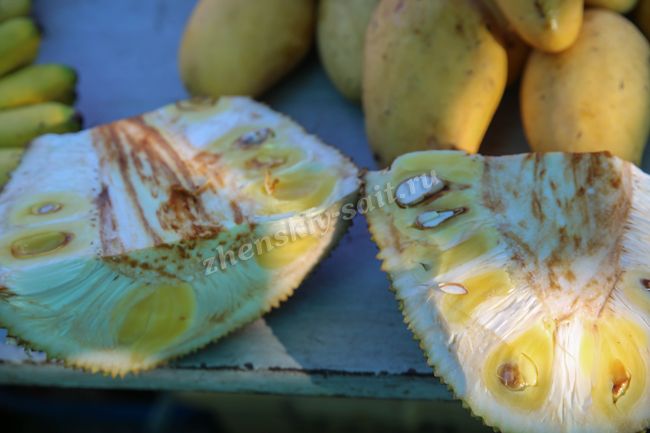
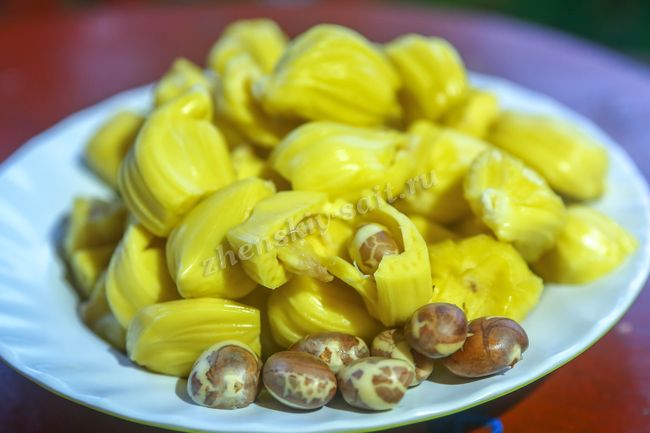
Its other more well-known name is Breadfruit. Jackfruit fruits can weigh up to 40 kg. From above, it is covered with a dense crust with many small spikes, under which lies a yellow-colored and sweet-tasting flesh with a pleasant smell. It is divided into separate parts - slices similar to a pear. Jackfruit slices are not soft - they crunch a little in the mouth. It tastes like DUSHES.
Compote or as a vegetable for accompanying exotic dishes. Sweet, colorful, full of vitamins and healthy, they are carried everywhere and eaten as they are, thus presenting a dessert or the perfect snack, without any guilt. However, let's face it, our fruit baskets aren't very original: apples, pears, oranges, bananas, grapes, and other small fruits of the season are the most common. But there are plenty of other fruits with a delicious flavor and texture more than the original that will stimulate your taste buds.
Since it is very difficult to cope with such a huge fruit on your own, it is sold already peeled and divided into slices. By the way, inside each of the slices of pulp there is a bone, which is used for separate cooking.
Breadfruit is in season from January to August, but it can be refrigerated for up to two months. The pulp of the fruit is sold in bags of about 10 slices each. The cost of one package will be 20 baht.
I want to draw your attention to the fact that some people have an allergic reaction after eating the fruit. A lump appears in the throat, which makes it difficult to swallow and breathe. Spasms pass within a few hours.
Dragon fruit or Pitahaya (Eng. Pitahaya, in Thai Geow mangon)
Price: from 30 to 50 baht/kg.
Season: all year round
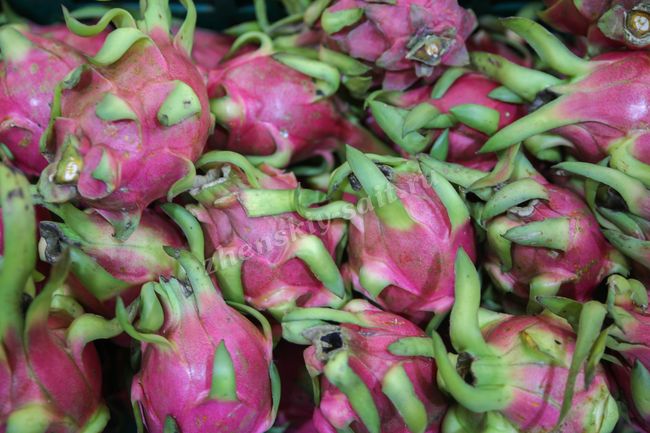
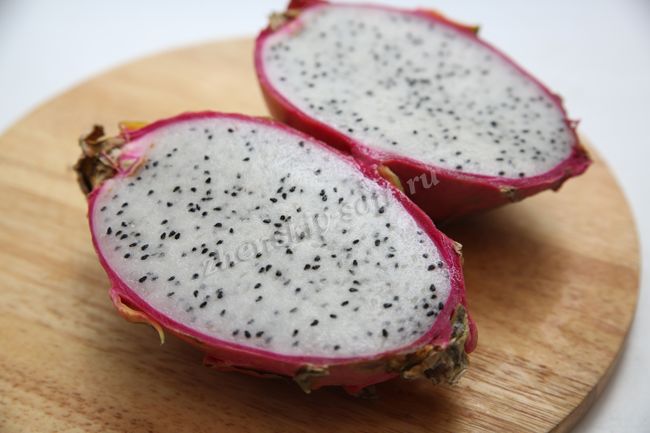
To be precise, this is not a fruit at all, but the fruits of a cactus. In Russia, it is often called the "Eye of the Dragon". The fruit comes from Australia, but it also took root well on the Thai islands. The fruit is quite large, about the size of a palm. On average, a fruit weighs 200-500 grams, but you can find specimens weighing up to one kilogram.
From above, the pitahaya is covered with large scales of red or raspberry color. Inside the fruit lies a white pulp, which is simply dotted with small black seeds. The taste of the fruit is very similar to kiwi, but not so rich. Some generally consider this fruit bland and tasteless.
Dragon fruit, before eating, is usually cut lengthwise, and the flesh itself is eaten with a spoon. But you can divide the pitahaya into slices and eat like a melon. The fruits are harvested all year round and cost an average of 35 baht per kg. From the pulp of the fruit, jams are made, jellies and juices are made, but most often it is used to make alcoholic beverages.
Noina (Noi-na) or Sugar apple (sugar apple English)
Price: from 30 to 80 baht/kg.
Season: June to September
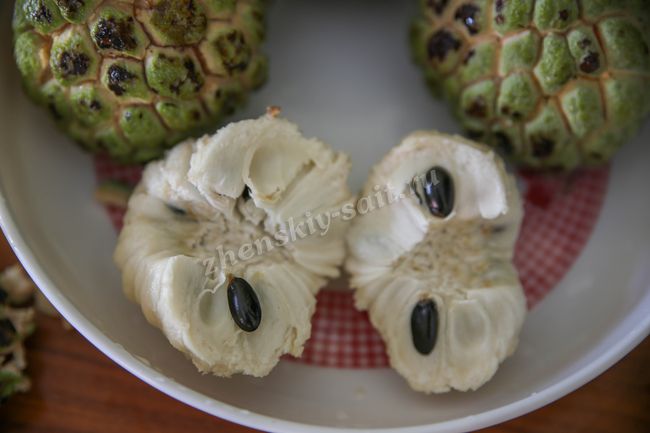
very unusual in its own way appearance fruit. Its fruit is similar in size and color to a green apple, but only very bumpy in shape. Under the bumpy peel hides a very sweet, crisp milky flesh, in which there are many seeds.
Ripe fruits are eaten with a spoon, cutting the fruit in half.
Choose this fruit carefully, because many who came across an unripe fruit really disliked it. The main noina collection season runs from June to September.
I give you a little hint for choosing a ripe fruit: it should be soft to the touch, and the scales of the peel can be easily removed. If the fruit is hard, then it is not yet ripe. Thais love to add this fruit to ice cream.
Rambutan (English Rambutan; Ngoh)
Price: from 10 to 40 baht/kg.
Season: May to September
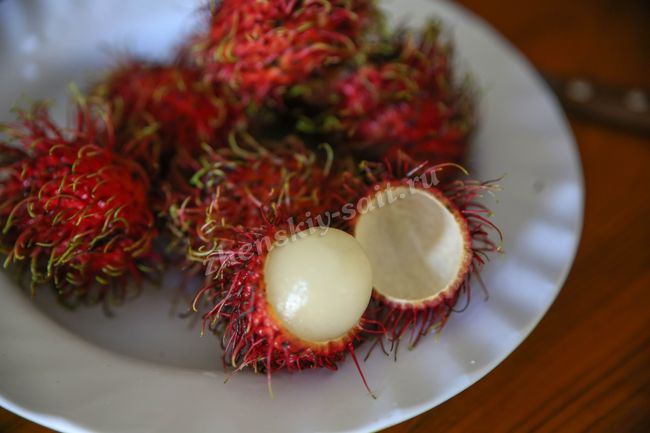
Such a fruit is simply impossible not to notice on the shelves. Its small fruits, about 5 cm in diameter, are red in color. They are covered with hairs that resemble thorns, but are soft to the touch.
When buying such a fruit, make sure that the peel is bright red and the villi are green at the tips. To peel the fruit, you need to cut the peel a little in the center, and then open it with your fingers by pressing on it.
Inside is a moderately sweet tender milky flesh. There is a small bone in the center of the fruit.
From the fruit you can make a very tasty jelly or cook compote. Rambutan is harvested between May and September and is sold at 35-40 baht per kg. But you can also meet 10 baht. For example, at a sale in Macro, Big C or Tesco Lotus.
Papaya (Papaya; Ma-Ia-ko)
Price: from 10 to 50 baht/kg.
Season: all year round

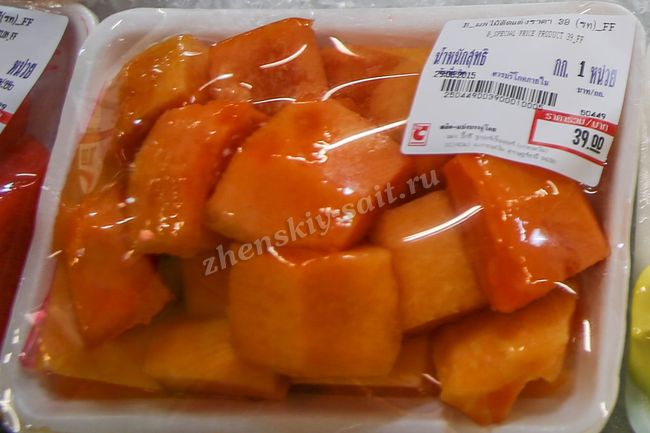
A very common southern fruit that grows on trees. In appearance, papaya resembles a zucchini. The unripe fruit is eaten as a vegetable.
But the ripe fruit has a very tender and sweet pulp, bright orange. The seeds are located in the center of the pulp. The taste of the fruit is something between a melon and a pumpkin. Due to the similarity in taste and composition with melon, papaya is sometimes called the "melon tree".
Papaya is harvested all year round. It is not expensive at all, about 20 baht per kg. Unripe papaya is the main ingredient in a spicy Thai salad.
I want to draw your attention to the fact that the juice of an unripe fruit is white. It is very poisonous, but during the ripening period it loses its poisonousness and becomes transparent and watery.
Passionfruit (Passion fruit)
Price: from 35 to 50 baht/kg.
Season: May to August
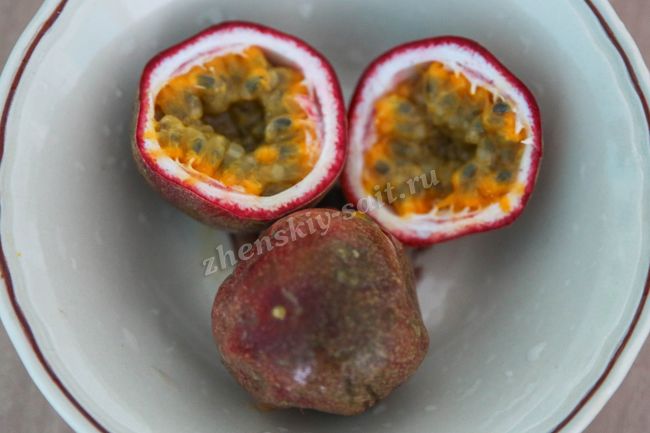
Passion fruits are similar in size and shape to a chicken egg. They are covered with an inedible skin of bright red, purple or burgundy colors. In order to enjoy the pulp, the fruit is cut in half.
The flesh of the passion fruit is like a bright yellow jelly and tastes sweet and sour. Very similar to sea buckthorn.
Of course, you can try the fruit in its pure form, but I recommend trying fruit juices and jellies. Be careful, the bones of the fetus cause drowsiness. Passion fruit bears fruit from May to August.
Salak (Salakh; Ra-kum)
Price: from 30 to 60 baht/kg.
Season: May to August

Another name for the fruit is "snake fruit", it got because of its peel resembling scales of snake skin. When cleaning the fruit, be very careful, its scales are sharp and dense, easily dig into the skin.
The flesh of the herring is dense, yellowish in color and is divided into several parts. It has a sweet and sour taste and an unobtrusive aroma. The harvest season is from May to August.
Guava (Guava; Farang)
Price: 30-50 baht/kg.
Season: all year round
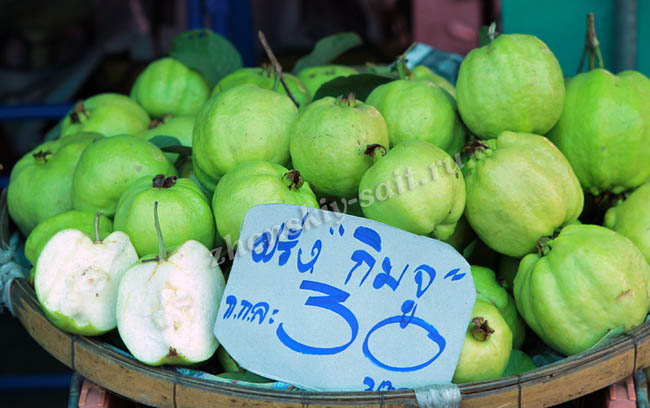
A traditional tropical fruit that looks like an apple with an uneven surface. The pulp of the fruit is firm, white or Pink colour with many small bones.
You should not expect too exotic taste from the fruit, but the aroma is simply magnificent. In addition, the fruit is very rich in vitamin C. They eat it along with the peel.
Lychee (Lichi; Lin-chi)
Price: 50-90 baht/kg.
Season: April to June only

This is a small fruit. round shape, with red bumpy skin. It easily falls behind the sweet white pulp.
The taste of the fruit is slightly tart with the smell of perfume. In the center of the pulp there is an oblong bone. It’s a pity, but you can enjoy fresh lychee only from May to June, for this reason the price of the fruit is quite high.
Lychee perfectly quenches thirst, so it is very often used to make soft drinks. Well, if you suffer from anemia, then this fruit is simply necessary for you.
Longan (Longan; Lam-yai)
Price: 20-50 baht/kg.
Season: June to September

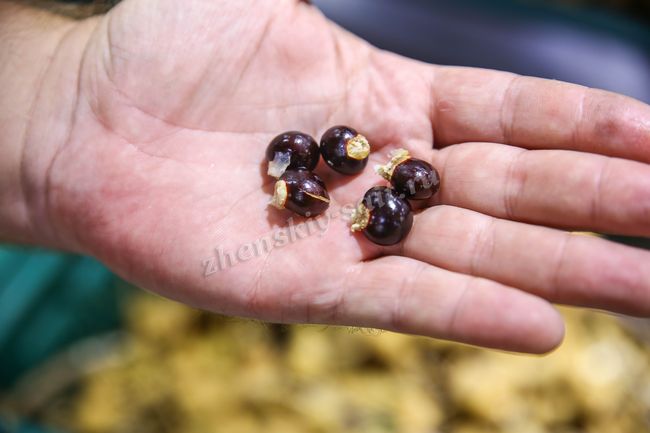
The fruit looks like nuts, but grows in clusters like grapes. Some people compare it with small potatoes in appearance. Its light brown peel is not edible, but it is very easy to peel off the pulp.
The translucent pulp of the fruit is juicy and sweet, with a bone in the center. Longan is one of the most beloved Thai fruits. They mostly eat it fresh, and in cafes, this fruit is often combined with ice cream. The pulp is similar in texture to grapes, it tastes sweet and juicy.
Longan is harvested from June to September.
Longkong (Longkong; Langsat)
Price: 30-90 baht/kg.
Season: June to October
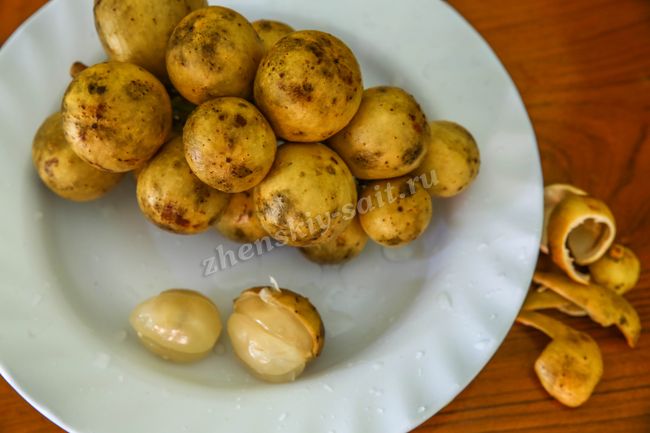
In general, both in appearance and growth, this fruit is very similar to longang. Its main difference is in the pulp. It is also divided into lobules and is translucent, but has a yellowish tint.
It tastes sweet, but with a slight hint of sourness and a taste of tree leaf buds.
You can enjoy this fruit from June to October. The average price for one kilogram is 40 baht.
Carambola (Start fruit; in Thai Ma-fuang)
Price: 40-50 baht/kg.
Season: October to December
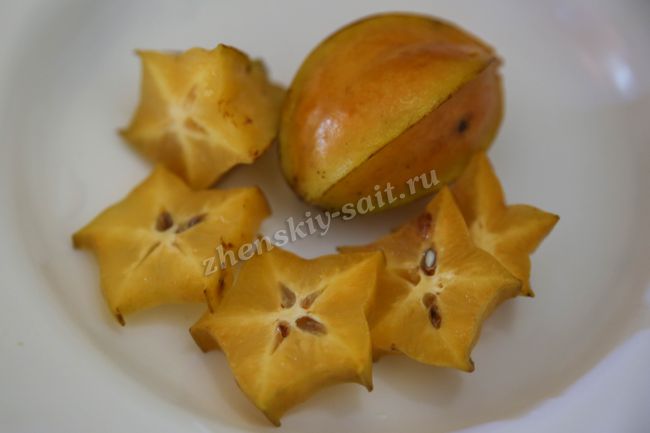
It is a four-sided fruit, yellow or yellow-green in color. In cross section, it is very much like a star. For this, the fruit got its second name "Star Fruit".
The fruit is completely edible. It tastes slightly sweet with sourness and very juicy. Something between a vegetable and a fruit. You can try carambola throughout the year, but the most delicious fruits will be from October to December.
This fruit is very often used for cooking. meat dishes, you can say they use it as a vegetable. Thais also consider carambola to be an excellent hangover remedy.
Sapodilla (Sapodilla; La-mut)
Price: 30-45 baht/kg.
Season: November to May
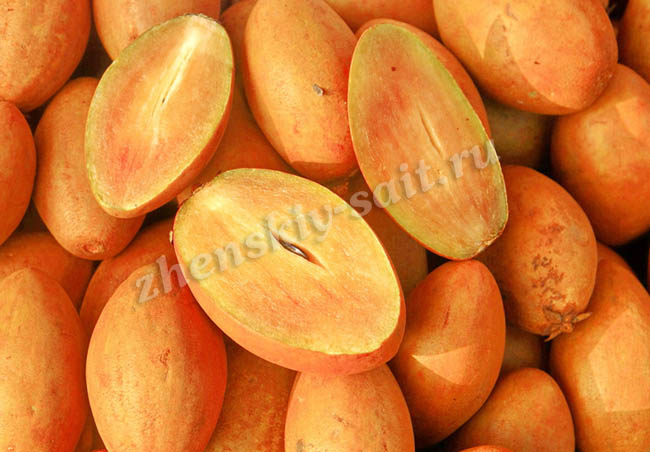
Externally, the fruit is small in size, with a light brown skin.
The pulp of the fruit is caramel in both color and taste, but to my great regret, it is absolutely not juicy, astringent. In the center of the pulp are small black bones with hooks on the tips. You have to be careful while eating it. You can also get hurt. The texture of the pulp is similar to persimmon.
The ripening season runs from September to December. The price is about 40 baht.
Tamarind (Tamarind; in Thai Ma-kham-wan)
Price: 50-80 baht/kg.
Season: December to March

The fruits outwardly strongly resemble bean or peanut pods. Yes, they are classified as legumes. Most often, it is not eaten fresh, but soaked to obtain juice. And already this juice is used in cooking. Candied fruits are also made from tamarind.
The hard shell of the fruit is very easy to peel off. And under it is a fibrous pulp with a tart, sweet and sour taste. She reminded me of thick jam. There are bones inside the pulp, so be careful when eating fruit.
Tamarind is rich in calcium, and vitamins A, B and C. When choosing a fruit, pay attention to its density, it should not be too soft. The harvest season for this fruit runs from December to the end of February. The fruit costs approximately 30 baht per kilogram. Tamarind fruits make excellent cold drinks. And Thais use this fruit as a seasoning for food.
Rose Apple (English Rose Apple, Thai Champoo)
Price: 40-100 baht/kg.
Season: June to September
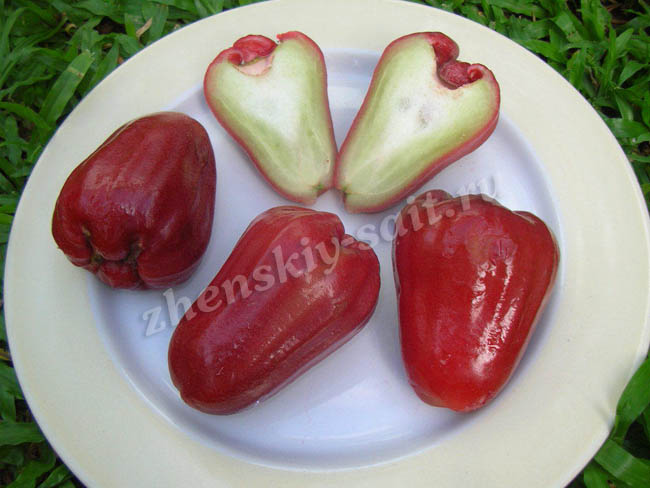
These attractive fruits are like bluebells. They come in different shades: from green to red.
The taste is crumbly, crispy, light with a refreshing taste. It is eaten whole without peeling. Not even seeds inside. Because of this, this fruit is often bought for children.
Tangerine or Mandarin (Tangerine; in Thai Som)
Price: 30-40 baht/kg
Season: all year round

It is one of the most popular citrus fruits. I will not describe it too much, because the taste and smell of mandarin is familiar to everyone!
However, Thai mandarin, or as it is correct in Thai, tangerine is different from all known fruits of ordinary mandarin. It is smaller, and its peel is very thin and has a bright green color. Yes, tangerine tastes sweeter.
Like all citrus fruits, the fruit is very rich in vitamin C. Tangerines are brought to Thailand from Vietnam and cost 65 baht, but homemade tangerine fruit costs only 30-40 baht.
Pomelo (Pomelo; Som-o)
Price: 20-40 baht/kg.
Season: all year round

Of all existing citrus fruits, this is the largest fruit. In appearance, it looks like a very large grapefruit, only depending on the variety, it has a green or yellow thick peel. The pulp of a pomelo is the same as that of a grapefruit, only not as juicy.
The taste of the fruit is sweet, with a slight hint of bitterness. The fruit is chosen for its bright aroma and soft peel. But the most important sign for choosing the most ripe fruit is the smell. The stronger and richer it is, the better the taste of the pomelo will be.
You can enjoy pomelo throughout the calendar year. But the price of fruit is different and depends on the region. On average, it ranges from 20 to 40 baht per kilogram.
Coconut (Kokonut; Ma phrao)
Price: 15-25 baht for a coconut in the store. And 30-40 baht on the beach or in the market.
Season: all year round
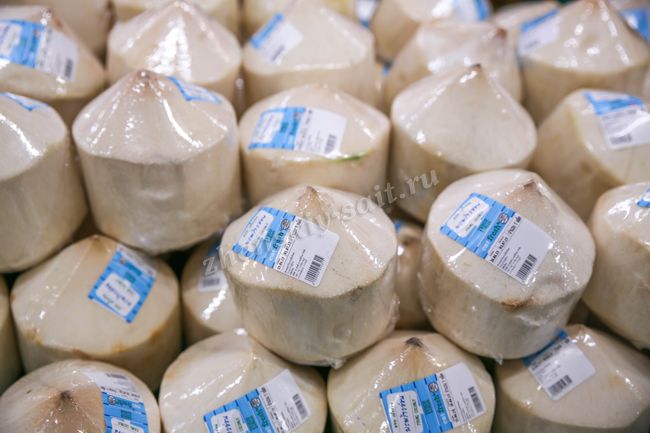
Coconuts are very widespread in the islands of Thailand. Coconut fruits grow up to three kilograms in weight. From above it is covered with a hard green shell and a dense shell.
The white flesh of the coconut is located right on the shell, in the center of the nut is a liquid that I call coconut milk. It has a sweetish aftertaste and perfectly quenches thirst.
Coconut is a source of sodium, phosphorus, potassium and calcium. You can enjoy coconut at any time of the year. But Thais love to eat coconut not only fresh. Roasted coconut is very popular in Thailand.
Banana (Banana; in Thai Kluai)
Price: from 20 to 40/kg.
Season: all year round
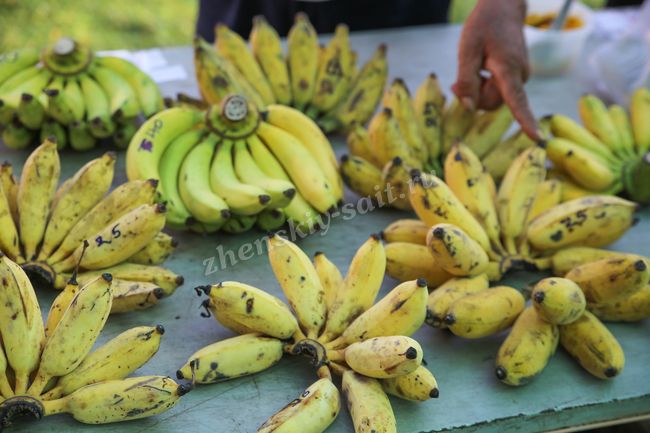
I can't tell you anything new about the banana. This is a well-known fruit that has an oblong shape and a bright yellow peel, behind which lies a delicate white flesh. Depending on the variety, it can be sweet or slightly astringent in taste. In Thailand, a large number of different types of this fruit grows.
Bananas are harvested here all year round, but the main peak is in December.
Pineapple (Pineapple; in Thai Sa-pa-rot)
Price: from 20 to 30 baht/piece + 10 baht to clean.
Season: all year round
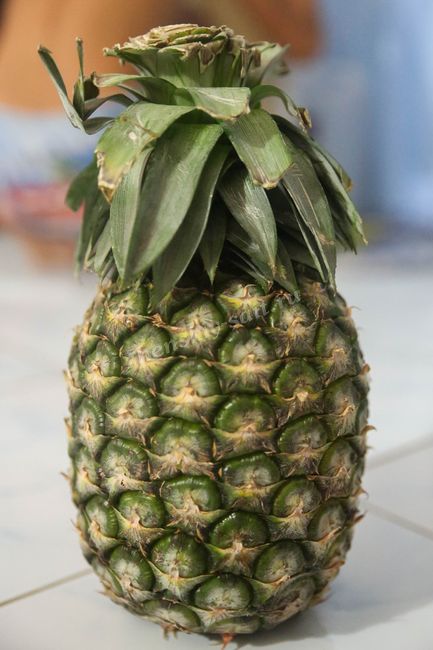
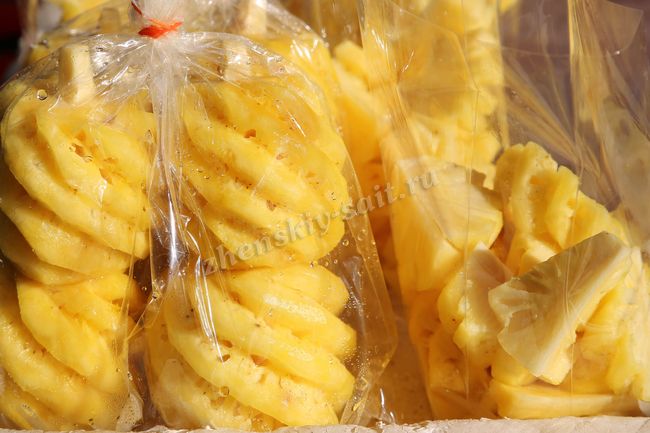
This fruit is well known to everyone. It has a rounded oblong shape. And the juicy, yellow pulp of pineapple is covered with a dense, angular peel. At the top of the fruit are long and hard leaves.
Thai pineapples are recognized as the most delicious in the world. They cannot be compared with pineapples that are sold in our country. Various varieties of fruit differ from each other mainly only in the size of the fruit. The taste of pineapple pulp is sweet, sometimes with a slight sourness.
Ripe pineapple flexes slightly under the fingers. But remember, only slightly, if strongly, then it means that the fruit is spoiled. The Thai pineapple season is in January and also April to June. The price per piece is approximately 25 baht.
Watermelon (Watermelon; taeng-mo)
Price: from 30 to 40 baht / piece.
Season: all year round

This fruit, and to be precise, a very large berry, has long been popular in all parts of the world. Watermelon fruits are not large, covered with a striped, green peel. However, in Thailand you will meet watermelons not only with the usual red flesh, but with bright yellow. Although, in my opinion, they taste exactly the same.
Watermelon pulp is soft, very juicy with lots of black seeds. You can enjoy watermelon directly without leaving the counter. The sellers will not only cut it into pieces and peel it off, but they will also give you a special stick so that you do not get your hands dirty while eating.
Thais often make juice from watermelon or generally eat it with salt. On average, a watermelon costs 50 baht apiece. Yellow will cost a little more.
Melon (Melon; cantaloup)
Price: from 20 to 40/kg.
Season: all year round
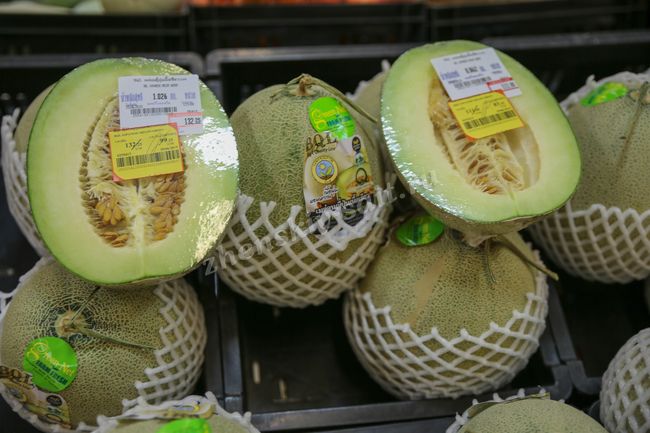

Thai melon Cantaloupe outwardly is very different from all the usual and known to us varieties and types of melons. On top of the melon is covered with a striped peel of green-yellow color. And the flesh of a ripe Thai melon itself is a rich orange color.
It is very juicy and honey-sweet in taste. By the way, about honey, Thais prepare honey from the pulp of this melon, which in these places is called bekmes. Cantapouls can be eaten both fresh and in various salads. And quite often, filling for baking is made from its pulp. Be sure to try! Believe me, it's very tasty!
Finally, I want to say: Do not try to try all exotic fruits at once! This can have a very negative impact on your health! And consequently, spoil the whole holiday! Try no more than two fruits a day. And then, take my word for it, you will only benefit from fruits, and you will have the most vivid and colorful impressions from a holiday in Thailand!
You may like:This fruit is native to tropical America but is also grown in Pakistan, India and the Philippines. Fruits are similar to pine cone, their diameter is about 10 cm. The fruit, which has a light taste of custard, has white flesh inside and a small amount of seeds.
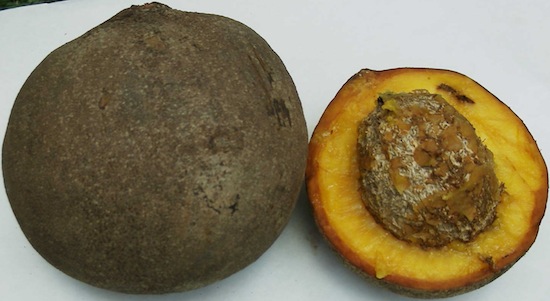
Mammaya americana is an evergreen tree native to South America, artificially planted in other regions of the world, including West Africa and Southeast Asia. The American apricot is actually a berry that is about 20 cm in diameter. The berry has a thick outer skin and soft orange flesh inside, usually one large seed in the center, however, large berries have about 4. The pulp is sweet and fragrant.
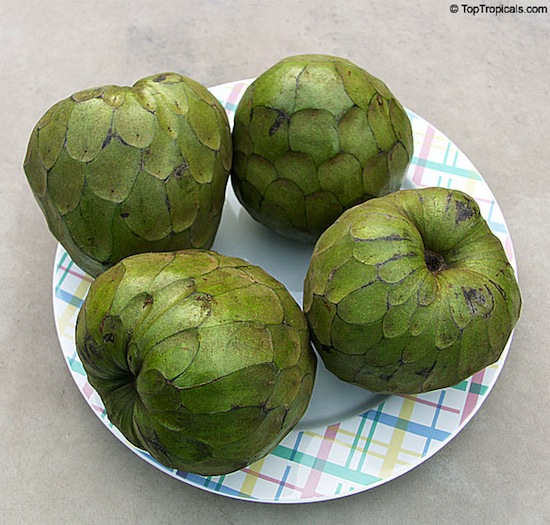
Cherimoya, or cream apple, is a deciduous plant native to the high mountain regions of South America. The fruit of the tree has a rounded shape with 3 types of surface (lumpy, smooth or mixed). The pulp of the fruit is creamy, very fragrant, white and juicy. The taste of the fruit is said to be similar to a combination of banana, passion fruit, papaya and pineapple. Mark Twain said in 1866, "Cherimoya is the most delicious fruit known."
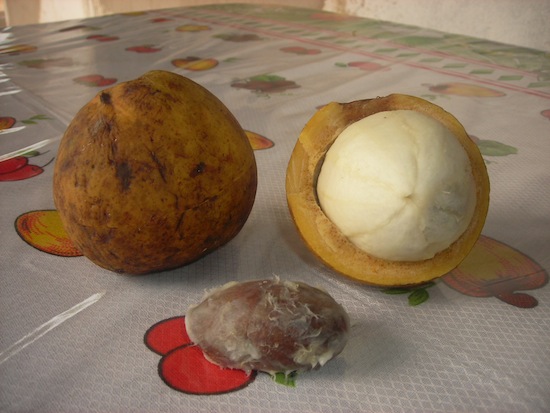
Platonia is a large tree (reaches a height of up to 40 meters) that grows in the rainforests of Brazil and Paraguay. The fruit grows to the size of an orange, and when pressed, a yellow liquid oozes out. Inside the fruit there is a white pulp, enveloping several black seeds, which has a pleasant sweet and sour taste.
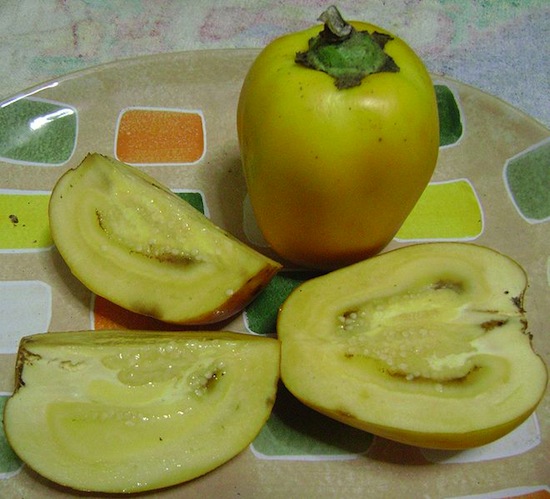
The cocoon is another tropical fruit that can be found in the highlands of South America. It grows on small shrubs, and it grows very quickly: in 9 months, fruits can be obtained from seeds, and after another 2 months they will finally ripen. The fruits are very similar to berries, and come in red, orange and yellow flowers. Outwardly, they are very similar to tomatoes, but the taste is a cross between a tomato and a lemon.
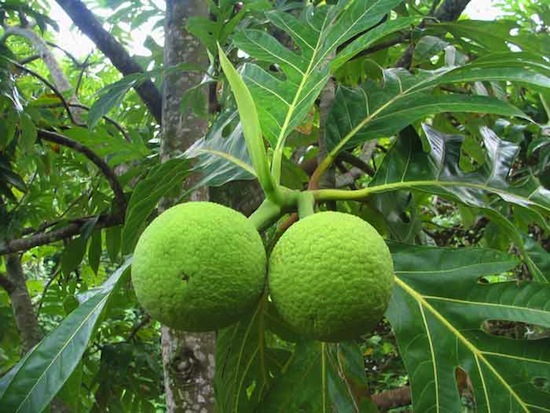
Breadfruit belongs to the mulberry family and is native to the Philippines and the islands of Southeast Asia. The fruits taste like a banana, they can be eaten raw when they are fully ripe, while unripe they can only be eaten cooked. The ripe fruit is soft and sweet, the unripe fruit is dense and starchy, but it got its name from the fact that, when cooked unripe, it tastes very much like freshly baked bread.
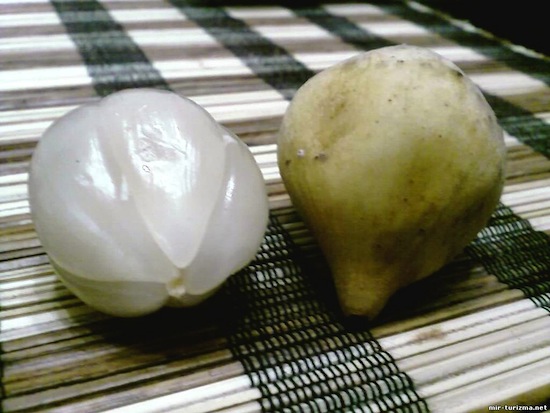
Langsat or duku are two very similar fruits found throughout Asia. They come from the same family, almost the same in appearance and taste, with only one difference. The peel of langsat contains a latex substance, which is not poisonous, but because of it it is difficult to remove it, while the peel of dooku is easily separated. There are 5 segments inside the fruit, some of which contain several bitter seeds. It is a very sweet fruit that can be prepared in a variety of ways.
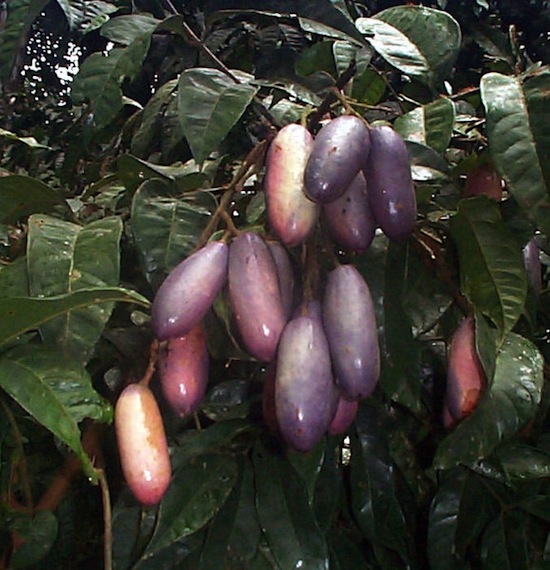
Dacryodes is an evergreen tree native to the tropical rainforests of Africa, northern Nigeria and southern Angola. The fruits, which range in color from dark blue to purple, are also known as African pears and are oblong in shape with pale green flesh inside. These fatty fruits have been claimed to end hunger in Africa as 48 percent of the fruit is made up of essential fatty acids, amino acids, vitamins and triglycerides. It was calculated that from one hectare planted with these trees, 7-8 tons of oil can be obtained, while all parts of the plant can be used.
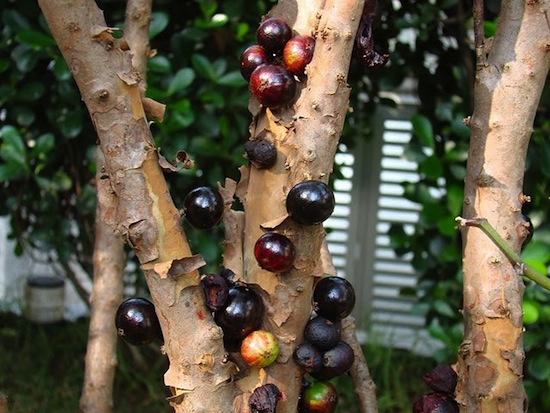
The Brazilian grape tree is a very strange plant native to Southeast Brazil. The strangeness of this tree lies in the way fruits grow on it. Initially, yellowish-white flowers appear on the entire trunk and large branches, then the flowers turn into fruits that are 3–4 cm in diameter. Inside the purple round fruit is soft gelatinous flesh with 1–4 black seeds. The fruit is very sweet, it can be eaten just like that, however, it is most often used to make wine or liquor.
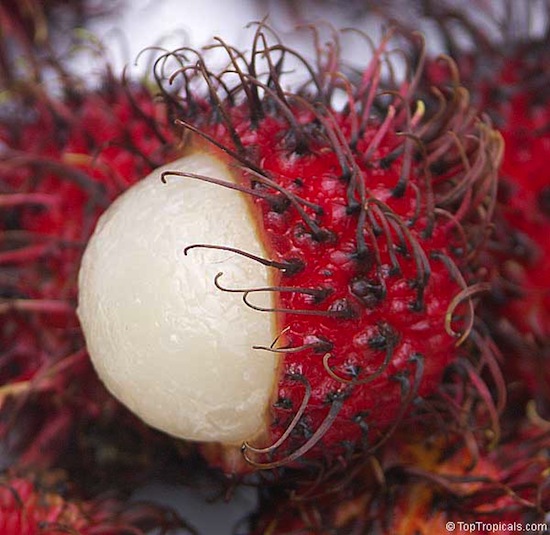
Rambutan is a strange-looking fruit that looks like a fluffy strawberry. Its homeland is Southeast Asia, but it is also widely distributed in other regions, especially in Costa Rica, where it is called the "Chinese sucker". Fruits, 3–6 cm in diameter, have oval shape. The flesh is a bit tough but easily peels off the skin, and rambutan tastes sweet and sour.
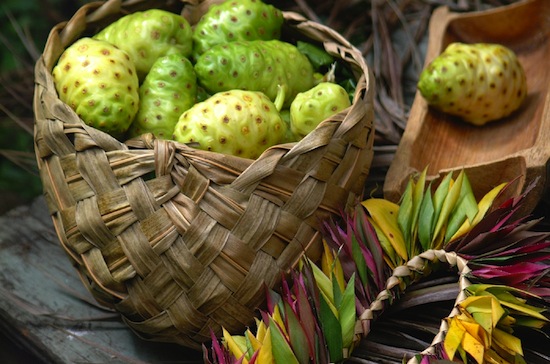
This fruit is known by many names, including large moringa, Indian mulberry, etc., its homeland is all over Southeast Asia and Australia, and it is also widely cultivated in the tropics. The tree bears fruit all year round, but as a rule, when the fruits ripen, the fruits have a very pungent odor. However, despite the smell, the fruit is high in fiber, vitamins, protein, iron, and calcium, and is a staple food in many Pacific countries. It can be eaten cooked or raw with salt.
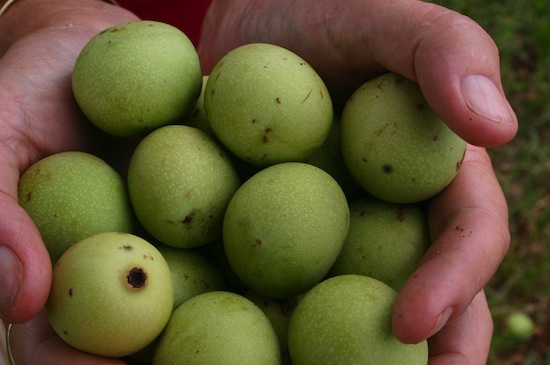
Marula is a deciduous tree native to South and East Africa. It now grows throughout Africa, as its fruits are an important food source for the Bantu peoples, and the trees appeared throughout their migration route. The green fruit ripens and turns yellow, and the white flesh inside is very juicy and has a pleasant aroma. After falling from the tree, the fruits begin to ferment almost immediately, so elephants and baboons in these regions are often slightly intoxicated. The fruit is also used to make the popular Amarula liqueur, which can be found in any duty-free store.
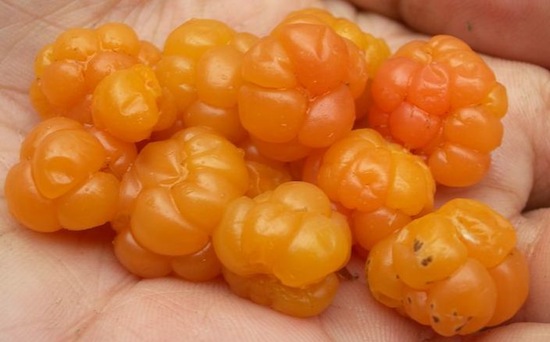
Cloudberry is a berry from the West Coast of North America. It is found in moist forests and grows in dense thickets. The fruit is similar to a raspberry, however, its color is more orange. They are very sweet, they are eaten both raw and processed into juice, wine, sweets and jams.
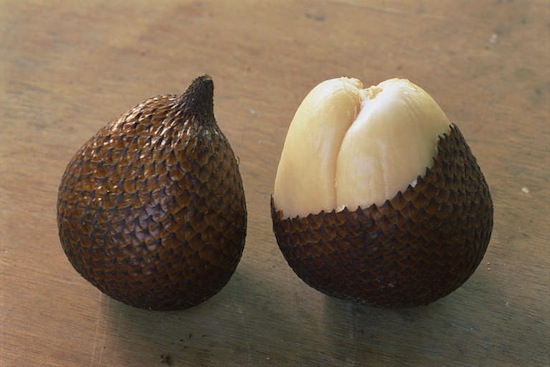
The snake fruit comes from Indonesia. They grow in clusters, and get their nickname because of the red-brown scaly peel, which is easily removed. Inside are 3 white sweet "segments", each containing small black inedible seeds. Fruits have a sweet and sour taste, similar in texture to apples.
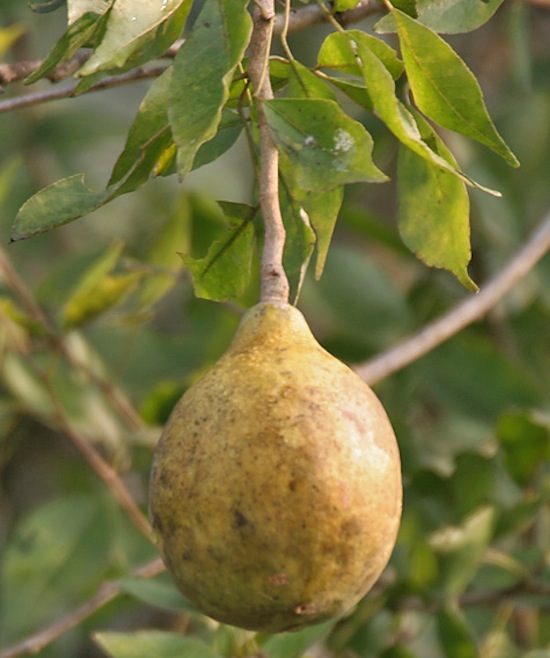
The bail, or stone apple, is originally from India, however, it can be found throughout Southeast Asia. Bail is a smooth fruit with a woody skin that can be dyed yellow, green or gray colors. The tough outer skin is so hard that the fruit can only be reached with a hammer. Inside is a yellow pulp with a few hairy seeds that can be eaten fresh or dried. Ripe fruits are often used to make a drink called sharbat, which also includes water, sugar and lime juice with pulp. Only one large piece of fruit is needed to make 6 liters of sharbat.

This fruit is native to the lowlands of Central America and Western India. The underside of the leaves of this evergreen tree shines golden color, noticeable even from a distance, and white or lilac flowers growing on a tree have a sweet aroma. The fruits are round in shape and purple in color, their skin is dense. If the fruit is cut horizontally, then the shape of a star in the pulp is clearly visible. Fresh fruits have a very sweet and pleasant taste.
17. Carambola (star fruit)
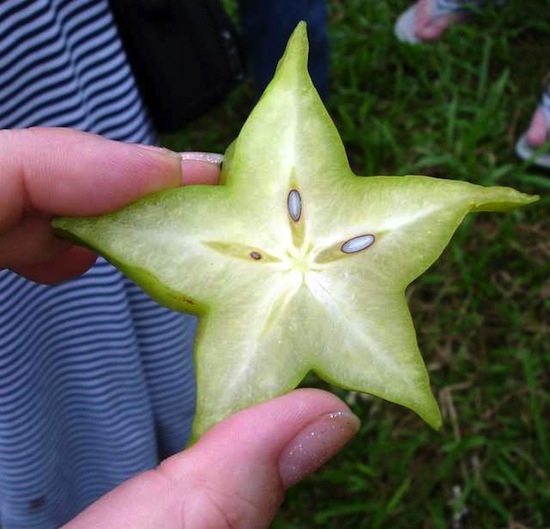
Carambola is fruit tree, originally from the Philippines, but growing throughout Southeast Asia, East Asia, South America. The shell of the fruit contains five "ridges", which, when longitudinal section becomes like a star, which is why, in fact, the fruit got its name. The fruit is rich in vitamin C and antioxidants. When ripe, the fruit becomes bright yellow, and it tastes very juicy and crispy.
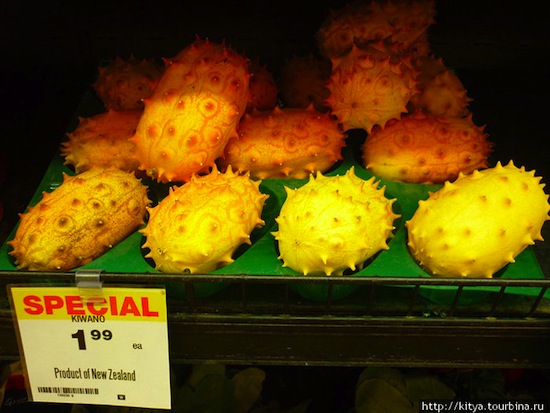
The horned melon, also known as the African cucumber, is native to Africa but is now also grown in Australia, New Zealand and Chile. When ripe, the skin of the melon is covered with dense, spiky yellow spikes, and the jelly-like flesh turns bright green. The taste of the fruit is often compared to that of a banana. The fruit is a good source of vitamin C and fiber.
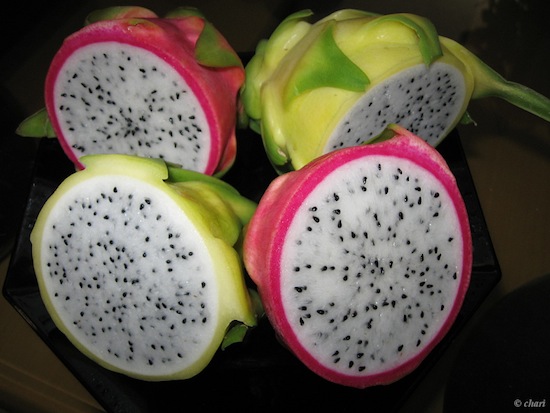
Pitaya, or cactus fruit, found throughout Asia, Australia, North and South America, was originally believed to be native to Mexico. There are two types of pitahaya: sour, commonly eaten in the Americas, and sweet, found throughout Asia. The fruits are red, yellow and purple, they have a very pleasant aroma, and the sweet appearance is very similar to kiwi in taste.
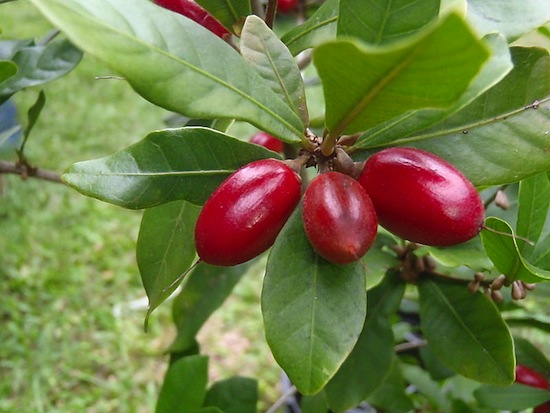
Miracle fruit, or sweet berries, are very strange berries native to West Africa. What makes these fruits and berries strange? Fruits in large quantities contain the sugar substitute miraculin in combination with a glycoprotein. The fruit itself does not have a very sweet taste, but after a person eats it, the glycoprotein binds the taste buds located on the human tongue and turns the taste of any product into a sweet one in about an hour. So you can eat a whole lemon and it tastes like sweet syrup.
In the 70s, attempts were made to serially sell the fruit as a dietary product, since it can turn any food into sweetness, while not affecting the number of calories consumed. However, it was not possible to achieve success in this field.
Popular
- Minimum old-age pension in Bashkiria
- Calculation of the minimum pension in Bashkortostan
- Family survivor's pension Survivor's pension what documents are needed
- Drawing up a story based on a picture of a hedgehog
- docx - Summary of GCD on cognitive development "If you want to be healthy - eat right!
- Report on summer recreational work in the senior group Analytical report of the educator on summer recreational work
- Parent meeting on the topic "safety and health of our children" Rod meeting in dow safety
- Proper organization of meals in groups (guidelines) How to organize meals in kindergarten
- How to determine acetone in urine using test strips
- What to do if your toenail is cracked




